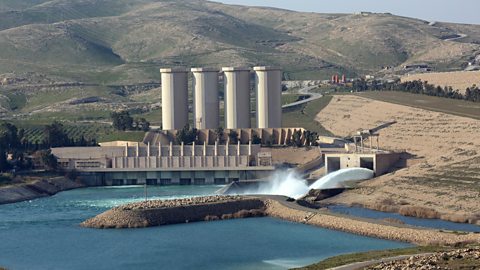Factors affecting water availability
There are several reasons why global water supply is not even. Access to a fresh water supply is affected by the following factors.
Climate
Low levels of rainfall and high temperatures lead to water deficitA place that has less water than required.. When rainfall is low, there is less water available. When temperatures are high, water evaporates and so there is less available to use. water surplusA location that has more water than required. are common where rainfall is high and temperatures are lower.
Geology
Rainfall flows down to the rocks beneath the ground. Some rocks are permeable rockA type of rock which allows water to pass through its joints and cracks, eg limestone. and allow water to flow through them. Permeable rocks can lead to less surface water. For example, limestone landscapes often have dry rivers - the rivers only exist when rain has just fallen. Permeable rocks form aquiferNaturally occurring underground water stores., which mean they are stores of water. 70 per cent of the water supply in the south east of England comes from the chalk aquifer beneath the surface. Other rocks are impermeableA substance which fluids are unable to pass through.. These rocks do not hold water, but they can trap it in the layers above.
Pollution
Some places have plenty of water, but pollution has made it unsafe to use. Untreated sewageWaste organic matter that sometimes pollutes water systems, eg faeces. and waste water from factories cause problems. groundwaterWhere water is stored in rocks beneath the ground. is usually cleaner, although pollutants can travel down into the ground. Gold mining near Johannesburg, South Africa, has led to uranium, arsenic and sulphuric acid polluting streams and rivers.
Over-abstraction
When water is taken from aquifers, groundwater levels fall. If the amount of water taken is greater than the amount of water falling as rain, it is called over-abstractionThe process of extracting too much water.. The Sonoran Desert in Arizona has experienced over-abstraction as water is taken for irrigation and urbanisation. The land here is subsidenceA fall in land levels. and water is becoming scarcer.
Limited infrastructures
Pipelines are needed to safely move water from place to place. Sealed pipes reduce the potential for leaks and pollution. Some places do not have these pipes in place. They can be expensive to lay as they need to be buried underground. Water pumps also form part of the water infrastructureThe basic structures needed for an area to function, for example roads and communications. . Water pumps in villages across Kenya were recently fitted with transmitterAn electronic device that produces radio waves. that send text messages if the devices break down.
Poverty
Nearly 1 billion people in Africa do not have access to clean, safe water. This locks them in a cycle of povertyA set of factors which keeps someone in poverty, without hope of an escape. - they cannot afford water so they become ill and when they become ill then cannot work and earn money.
Politics
Communication needs to take place within countries and across borders. There needs to be cooperation between states for the use of water resources that cross international borders. If, for example, water is polluted in one country then this will affect all other countries downstream.
Water politics, sometimes called hydropolitics, is politics affected by the availability of water resources. The River Nile, for example, is the primary water source for both Egypt and Sudan. The Nile is classed as an international river and flows through nine countries before reaching the Mediterranean Sea.
Impacts on water insecurity
Water security is when the entire population of a country has sustainable access to adequate quantities of acceptably clean water. There are several impacts of water insecurity. Some of these impacts are linked in a cycle of poverty.
Lack of clean piped water
Many girls across Africa spend hours walking to collect water rather than attending school.
Waterborne disease
Drinking or using dirty water puts people at risk of waterborne diseaseDiseases spread by contact with infected water. and illnesses, such as diarrhoea, malariaA potentially fatal disease spread by mosquitoes. and schistosomiasis. Schistosomiasis is an illness caused by a parasitic worm that enters the body through the skin coming into contact with water that contains untreated sewage. It has been reported in 78 countries and 90 per cent of people receiving treatment for it live in Africa.
Food production
Water insecurity can lead to lower levels of food production. irrigationIrrigation is the channelling of water from rivers and streams to fields in order to help crops grow. can increase crop yields by as much as 400 per cent. Places that do not have enough water to irrigate crops have less food to eat.
Industrial output
Industry needs water for all stages of production. Water is used as a raw materialBasic material that goods are made from such as crops, metals, wood and animal products such as wool and leather., a coolant, a method of transport, and in some cases, a source of energy. Areas that experience water insecurity are unable to operate factories and make products. This leaves them relying on imports, which may be expensive.
Conflicts
Water is a source of conflict in some parts of the world. Seizing damA large concrete wall built to trap water in a reservoir. is a powerful way of controlling water and hydroelectricity supplies.
